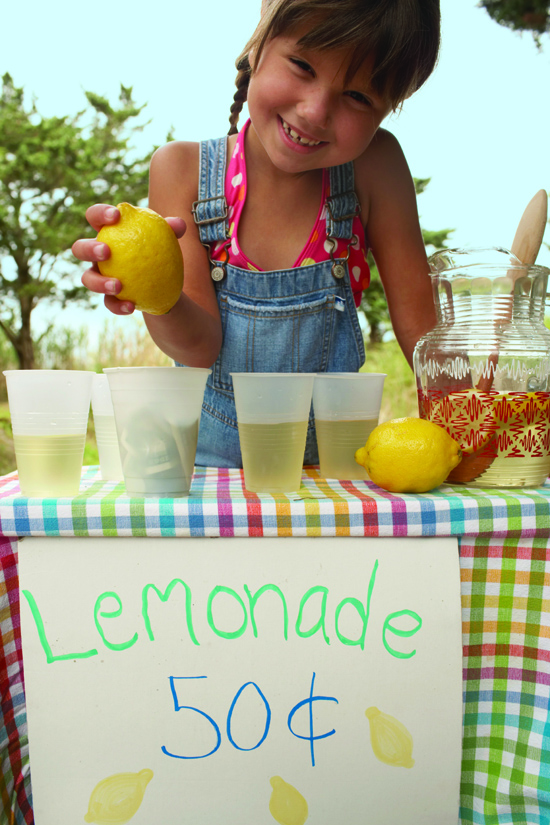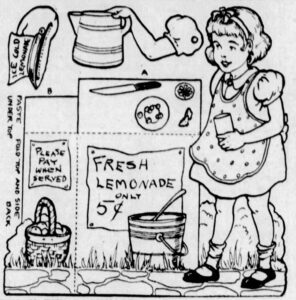
By Kris Leonhardt
Editor-in-chief
GREEN BAY – The American lemonade stand began lining city streets in the 1800s, as entrepreneurs took the thirst-quenching drink out of the barroom and into the sun-filled summer days.
“This cheap lemonade business has come very much to the front in New York within the last year of two,” a July 1880 New York Times article stated, adding that “scores of them had been established.”
For a mere five cents, a weary traveler could enjoy an ice-cold glass of the freshly-squeezed concoction from a sidewalk vendor.
In the 1900s, families started to move into city suburbs and children were attending mandated school and looking forward to summer break.
As summer drew near, adults and children began looking forward to a taste of the refreshing drink on a hot summer day.
Parks and beaches began introducing lemonade stands on their grounds, including a fairly new Bay Beach in Green Bay, where a new bathhouse was being constructed.
Mitchell R. Nejedlo, who purchased the land for a resort area, began work on a lemonade and band stand in August 1900.
“The lower floor will be used as a lemonade stand while the upper part will be fitted for the use of [bands],” a Green Bay Semi-Weekly Gazette article stated.
At the same time, kids began exploring free enterprise by setting up their own curb-side stands to lure the ever-thirsty consumer.
Lemonade stands soon became a rite of passage for those age six to 10.
However, by the 1950s, homemade lemonade stands began to disappear — possibly due to the invention of mass-produced lemonade or the safety concerns that have grown more visible and possible over the decades.

The Green Bay Press-Gazette mourned its demise.
“The reasons for the lemonade stand’s demise are probably quite complex and might provide a good thesis subject for a social study student some day. Cars go by too fast now to stop in time. There are usually plenty of bottle soft drinks in the refrigerators, too. Our kids are kept so busy these summers with organized play and camps they no longer find the long bored hours in which to cook elaborate financial plans. And those lemons and the sugar make quite a hole in the budget,” a July 1951 article read.
The nostalgia of it all prompted the publication to assign a lemonade stand project to “junior editors” a couple of years later, touting as a way to earn money for Sunday School or ice cream.
But the desire to allow a child a chance at entrepreneurship for parents and customers alike has kept the lemonade stand alive.
Legislation in the past decade nearly put an end to the curbside stand, however it now limits the amount of money kids can make and what can or cannot be sold with the lemonade.
Children under 18 can operate a stand on private property and without a permit if they sell no more than $2,000 in one year, or 8,000 cups at 25 cents.
Young entrepreneurs are also blocked from selling food that could become a hazard, such as egg salad.
Today, the majority of kids lemonade stands serve as fundraisers for charities and lessons in finance and are making a comeback after stalling during COVID-19.
Safety tips
The following are recommendations from the Illinois Department of Public Health
Always use clean and safe water and ice
Use tap water from your kitchen sink or refrigerator to make drinks and ice. Don’t use water from a bathroom sink or hose because it may not be safe. If you have a private water well, use store-bought water and ice.
Clean hands keep food safe
Be sure to wash your hands often and especially after using the restroom, eating or touching money.
Make your drinks using safe ingredients
Use pre-packaged beverage powder mix or pre-packaged frozen concentrate. If you’re using fresh lemons, ensure they are properly washed with clean water before cutting them and store them in a clean container. Make sure that any utensils and surfaces like knives and cutting boards are cleaned regularly.
Don’t touch ice with bare hands
Use a clean ice scoop or tongs when getting ice to prevent touching ice with your bare hands.
Keep your drinks safe from bugs and dirt
Use a plastic pitcher with a lid to keep the lemonade covered between customers. Store drink pitchers and ice off the ground.
Getting started
The following is advice from kidsmoney.org. Visit the site for more tips.
Location, location, location
Choose a location with a lot of traffic, especially pedestrian foot traffic and where adults are likely to carry cash or loose change. My nieces live up the mountain on a highway with no foot traffic, so we set up shop at my house in the city with a lot of foot traffic.
Marketing and advertising your business
Let your imagination run wild and spread the word about when you will be selling lemonade, and any other fun treats you’ll be adding to your menu. We made fun flyers and hung them on the community boards at local churches and businesses in the area near my house; then we knocked on doors to introduce ourselves and our business to my neighbors.
Offer more than lemonade
We chose to create a menu that included sweet treats like cookies, cupcakes and lollipops, which the girls loved to help me make in the kitchen. I wrote the menu and prices on a dry-erase board so we could change the prices as needed because grocery costs have changed so frequently this summer.
Strategize the right price
If you develop a great recipe for lemonade and treats that are high quality and taste great, don’t be afraid to charge higher prices than competitors. Part of the strategy of determining your prices should be how much your supplies cost.
Give some of your earnings to worthy charities
Learning about giving to charity as a kid is the greatest gift my own parents taught me. It taught me compassion, and we are teaching that gift to my nieces now.
